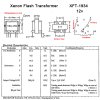Hey guys,
I just got all the parts in and I've been trying to build this (seemingly) simple circuit, and I've been trying to get it to work for literally 6 hours! The circuit uses the 6v (XFT-1610) transformer, and I've replaced it with the 12V (XFT-1934) transformer for use with 12v input voltage.
I cannot seem to get more than 1-2 volts out of it, while it should be stepping up to 300 volts!
I've marked the pins of the transformer in red on the circuit picture below to make it easier to follow what I've done:
° Transformer Pin #1 connected to +12V input, as well to Pin #3 through a 1K resistor.
° Transformer Pin #2 connected to the "negative" side of 300V film capacitor.
° Transformer Pin #4 connected to 2SD882 Collector.
° Transformer Pin #5 connected to 2SD882 Base.
° 2SD882 Emitter connected to -12V input, as well as to "positive" side of 300V film capacitor.
Am I doing anything wrong? I can't seem to get more than a 1-2 volt output. ANY help or ideas would be highly appreciated!
Click on the pictures to make them larger:
**broken link removed**
**broken link removed**
**broken link removed**
**broken link removed**
Thank you so much!
I just got all the parts in and I've been trying to build this (seemingly) simple circuit, and I've been trying to get it to work for literally 6 hours! The circuit uses the 6v (XFT-1610) transformer, and I've replaced it with the 12V (XFT-1934) transformer for use with 12v input voltage.
I cannot seem to get more than 1-2 volts out of it, while it should be stepping up to 300 volts!
I've marked the pins of the transformer in red on the circuit picture below to make it easier to follow what I've done:
° Transformer Pin #1 connected to +12V input, as well to Pin #3 through a 1K resistor.
° Transformer Pin #2 connected to the "negative" side of 300V film capacitor.
° Transformer Pin #4 connected to 2SD882 Collector.
° Transformer Pin #5 connected to 2SD882 Base.
° 2SD882 Emitter connected to -12V input, as well as to "positive" side of 300V film capacitor.
Am I doing anything wrong? I can't seem to get more than a 1-2 volt output. ANY help or ideas would be highly appreciated!
Click on the pictures to make them larger:
**broken link removed**
**broken link removed**
**broken link removed**
**broken link removed**
Thank you so much!




